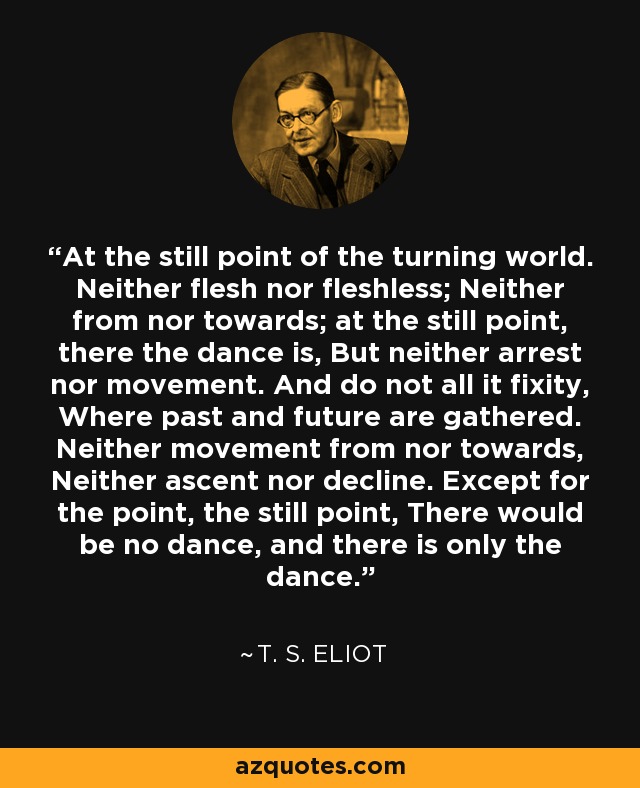Gallery: Dance
- Home Page 178

Style Men
This content is accessible to paid subscribers. To view it please enter your password below or send mike@standardsmichigan.com a request for subscription details.
Spring Week 17 | April 21 – April 27
“The Dry Salvages” | No. 3 of the ‘Four Quartets’ by T.S. Eliot, 1946
I do not know much about gods; but I think that the river
Is a strong brown god—sullen, untamed and intractable,
Patient to some degree, at first recognised as a frontier;
Useful, untrustworthy, as a conveyor of commerce;
Then only a problem confronting the builder of bridges.
The problem once solved, the brown god is almost forgotten
By the dwellers in cities—ever, however, implacable.
Keeping his seasons and rages, destroyer, reminder
Of what men choose to forget. Unhonoured, unpropitiated
By worshippers of the machine, but waiting, watching and waiting.
His rhythm was present in the nursery bedroom,
In the rank ailanthus of the April dooryard,
In the smell of grapes on the autumn table,
And the evening circle in the winter gaslight….
Mississippi State University: National Poetry Month 2023
Monday | 21 April | Colloquium 15:00 UTC
Tuesday | 22 April | Colloquium 15:00 UTC
Wednesday | 23 April | Colloquium 15:00 UTC
Thursday | 24 April | Colloquium 15:00 UTC
Friday | 25 April | Colloquium 15:00 UTC
Saturday | 26 April
Sunday | 27 April
CSA Z614-2020: Children’s Playground Equipment
This content is accessible to paid subscribers. To view it please enter your password below or send mike@standardsmichigan.com a request for subscription details.
Investigating the Perceived Impact of Maternity on Software Engineering: a Women’s Perspective
Investigating the Perceived Impact of Maternity on Software Engineering: a Women’s Perspective
Abstract: Background: Several researchers report the impact of gender on software development teams, especially in relation to women. In general, women are under-represented on these teams and face challenges and difficulties in their workplaces. When it comes to women who are mothers, these challenges can be amplified and directly impact these women’s professional lives, both in industry and academia. However, little is known about women ICT practitioners’ perceptions of the challenges of maternity in their professional careers. Objective: This paper investigates mothers’ challenges and difficulties in global software development teams. Method: We conducted a survey with women in the ICT field who work in academia and global technology companies. We surveyed 141 mothers from different countries and employed mixed methods to analyze the data. Results: Our findings reveal that women face sociocultural challenges, including work-life balance issues, bad jokes, and moral harassment. The prejudices they suffer make them insecure and with low confidence in the work performed. Furthermore, they usually do not have a supporting network during and after maternity leave, which culminates in them feeling overloaded. The surveyed women suggested a set of actions to reduce the challenges they face in their workplaces, such as: creating a code of conduct for men and childcare within companies. Conclusion: Women face many challenges when they become mothers. Our findings explore these challenges and can help organizations in developing policies to minimize them. Also, it can help raise awareness of co-workers and bosses, toward a more friendly and inclusive workplace.
Pollinator Research
This content is accessible to paid subscribers. To view it please enter your password below or send mike@standardsmichigan.com a request for subscription details.
Champion
This content is accessible to paid subscribers. To view it please enter your password below or send mike@standardsmichigan.com a request for subscription details.
Race, Merit, and The Future of Our Republic
This content is accessible to paid subscribers. To view it please enter your password below or send mike@standardsmichigan.com a request for subscription details.
North Park University Lake County
This content is accessible to paid subscribers. To view it please enter your password below or send mike@standardsmichigan.com a request for subscription details.
Zur Quantentheorie kontinuierlicher Spektren
This content is accessible to paid subscribers. To view it please enter your password below or send mike@standardsmichigan.com a request for subscription details.
New update alert! The 2022 update to the Trademark Assignment Dataset is now available online. Find 1.29 million trademark assignments, involving 2.28 million unique trademark properties issued by the USPTO between March 1952 and January 2023: https://t.co/njrDAbSpwB pic.twitter.com/GkAXrHoQ9T
— USPTO (@uspto) July 13, 2023
Standards Michigan Group, LLC
2723 South State Street | Suite 150
Ann Arbor, MI 48104 USA
888-746-3670










